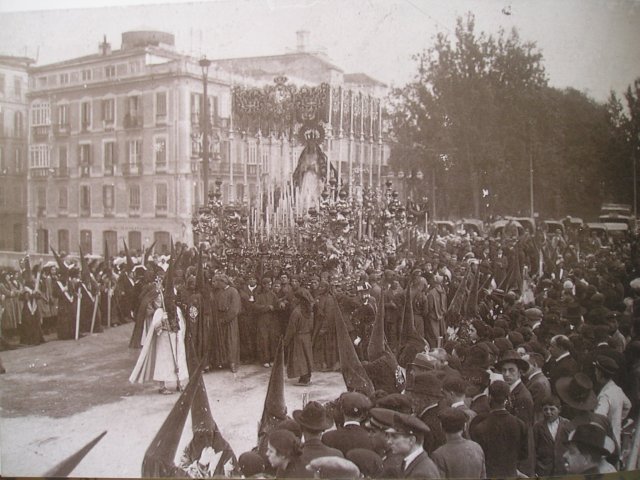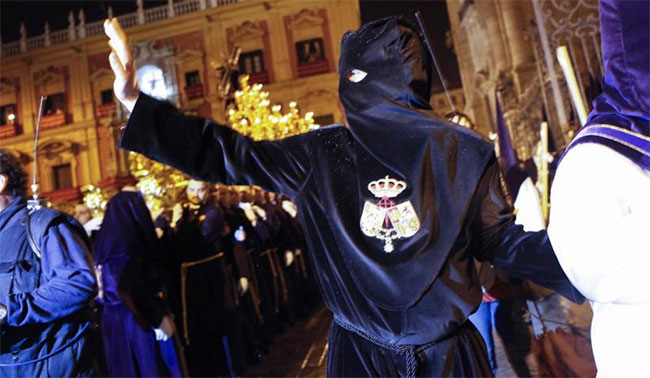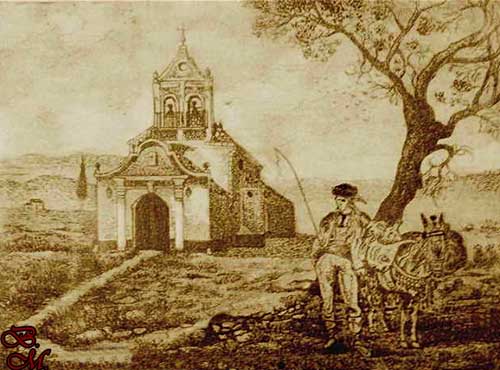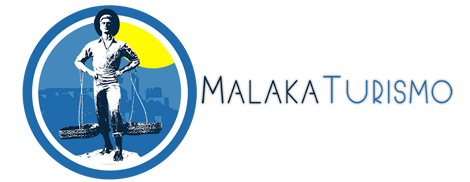Malaga’s Easter Week is one of the most important events locally, attracting millions of people from all over Spain and the world, as the mix of culture, tradition and celebration has made it an extraordinary event not to be missed.
This event, known as Big Week, takes place from Palm Sunday to Resurrection Sunday. During these 7 days more than 40 brotherhoods will take to the streets, carrying images of the Christ and the Virgin, dressed in different clothes and arrangements that make them so distinctive among them, and among the rest of the cities.
1. History of the Easter Week in Malaga
If we look back in time, the celebration of Holy Week today has nothing to do with its beginnings, although it continues to be for many a purely religious act, it has become for many others a simple tradition, without such a pure meaning.
The celebration of the Easter Week in our city has its beginning with the Reconquest by the Catholic Kings in 1487, fervent believers, and that had as objective to finish with the Muslim influence, that was present during centuries. The Church had the mission to impose the Catholic faith among the people and fight against the heresy, that is why they promoted the worship of the Holy Images.
In the beginning, the images were carried by about 10 people (nowadays there are images carried by more than 250 men).These images were accompanied by a procession of Nazarenes and the so-called “blood brothers” or disciplinarians, who whipped each other throughout the entire route, to the amazement of the people.

Over the centuries there have been many currents and other factors, such as political, social or economic, that have transformed the celebration of Holy Week in Malaga and the way it is perceived. In the nineteenth century, the invasion of Spain by Napoleon caused the brotherhoods of that period to lose much of their wealth.
The 20th century can be defined as the beginning of the current Easter Week, there have been many factors that have made it what it is today. With the creation of the Association of Brotherhoods, at the beginning of the century, it was exported to other places and began to bring tourists from other parts of the country, generating an important economic income, which continues today, with millions of visitors every year.
The Civil War, as it happened in the previous century with Napoleon, left the brotherhoods in a very delicate situation, as many images were burned and they lost a great part of their patrimony. But as with the Catholic Monarchs, the nationalist victory meant that Easter was once again celebrated as a sign of victory over the Republicans.

2. Why visit the Easter Week in Malaga?
Easter Week in Malaga is, from a liturgical and cultural point of view, one of the most important events that takes place every year in Malaga. It has been declared of International Tourist Interest since February 1980.
Many people from Malaga accompany the images wearing the habit of the Nazarene carrying candles, crosses or behind the images as a promise. Others carry out the station of penance carrying on one of their shoulders the processional walks as men of the throne.
Malaga’s Holy Week shares with the other Andalusian celebrations a great popular fervour and artistic forms such as the “saeta”. It is distinguished from the others by features such as the physical support of the images and the vocabulary of the brotherhood, which is largely specific to Easter Week in Malaga.
There is great devotion to this religious and cultural festival on the part of the people of Málaga, since if we look at the figures, 80,000 people are brothers of one of the brotherhoods of the capital, which means that more than 10% of the population actively collaborates in one of them. Every year in Malaga more than 20,000 people participate in the processions as Nazarenes and 30,000 as men on throne.

Within the national area, we can observe that where there is more tradition of Holy Week is in Andalusia, since it extends for centuries, and specifically Seville and Malaga are the most outstanding for their fervor, for their routes and their images.
Malaga differs from the majority of cities where they are held both in terms of the way the image is carried and the size of the images.While in the rest of Spain they are carried in sacks (that is why they are called costaleros), where they carry the weight underneath the same area, in Malaga they are carried on the shoulders and are called hombres de trono.
Without a doubt, the biggest difference that gives it such honorable prestige at the national level is, without a doubt, the union that some brotherhoods have with the Legion, the Navy, the paratrooper corps, the Civil Guard or the national police force. The presence of the legion with the Mena procession is well known outside the provincial boundaries, causing the presence of tourists from all parts of Spain and abroad to increase significantly on Holy Thursday. The navy, the parachutists… are undoubtedly unique tourist attractions, since nowhere else in the country do the military and the brotherhoods have such a proven link.
3. Traditions and Legends
Malaga, due to its long and tortuous history, is rich in legends and brotherhood traditions:
1. The Christ of the Blood
In a city with a seafaring character like Malaga, a legend linked to fishermen could not be missing. It is said that a group of them, embarked on board a seine, were surprised by a storm while they were fishing, with the misfortune that the waves pushed them away from our coasts. In spite of their efforts to dominate the boat and reach the mainland, they turned out to be sterile. Amidst black clouds and defiant waves they commended their souls to God, believing their end to be imminent. And behold, after prayer, a ray of light arose from heaven, a clearing was formed in the midst of the waves, and in that place appeared the carving of a crucified Christ.
At once the mariners directed their boat towards the Image, rescuing it from the waters and realizing that blood was flowing from its side. The storm finally subsided and they were able to go safely to land with the Image of Christ Crucified, which was taken to the old Convent of La Merced where it would be venerated since then as the Christ of the Blood.
2. The release of the prisoner
In the time of King Charles III a serious epidemic of plague ravaged the city, with a large number of people dying. The weakness of the survivors made it difficult to hold prayerful processions imploring the end of the epidemic. One of the places where the disease had not attacked with such virulence was the prison.
The prisoners, aware of what was happening outside the walls where they were deprived of their freedom, asked the warden to allow them to leave in order to take out in procession the venerated Image of Our Father Jesus entitled “The Rich One”. In view of the Authority’s refusal, for the well-founded fear that the prisoners could take advantage of the circumstance to escape, they decided to rebel, fulfilling their promise to carry out the requested procession. After the procession, they returned, as they had promised, to the prison, except for one of them who did so the next day, carrying a head of Saint John the Baptist, which he placed next to the bed of a fellow prisoner who was also ill and who, like the rest of the population of Malaga, was healed a few days after the event.
The King, moved by the generous action of the prisoners, issued a Decree by which, every year, during the procession of “El Rico”, a prisoner would be granted his freedom. This tradition has been maintained to this day.

3. The bandit of Zamarilla
In the time of the bandits, one who was nicknamed “El Zamarilla” was especially famous. He committed multiple misdeeds, and such was his reputation and the dangerousness of the gang he captained that the bailiffs decided to form a special unit to capture him at any cost.
After several skirmishes, they managed to hunt and capture them, but “El Zamarilla”, fast and elusive like no one else thanks to his knowledge of the terrain, escaped, although he was closely followed by a patrol.After many leagues at a gallop, and with the bailiffs hot on his heels, the bandit reached a hermitage looking for a hiding place to avoid being captured, and the only place he found was under the mantle of a holy image that was venerated there. His pursuers entered, and although they searched the small chapel from top to bottom, they did not discover it.
Some time later, feeling safe, the bandit left his refuge and, giving thanks to such a proverbial Saviour, he plucked a white rose from the path of the hermitage and pinned it to the breast of the Image, using his own dagger as a pin. At that moment the rose was dyed red. Terrified, the bandit knelt at the Virgin’s feet and implored her forgiveness for his ungodly life. From then on, “El Zamarrilla” became a hermit who went down to visit his beloved Virgin on some occasions.

On one of those occasions, when he was already old, some bandits assaulted him, pretending to steal what little he had. In spite of his age, “El Zamarrilla” kept some of the vigor of his youth and resisted, so the assailants wounded him and he ran away. As he could, he reached the door of the chapel, carrying a red rose in his hands as an offering, as he always did. Before he died he looked at his Virgin and saw how the rose he was holding in his hands was fading to white: She had forgiven him.
Today the “Virgen de la Amargura” still lives in the chapel that bears the name of Zamarrilla, she still wears a red rose and a dagger on her chest, and only on Good Friday does she wear a white rose, forgiving us all for the death of her Son.
4. Easter Week in Malaga. An international event
As we have spoken before, the Easter Week of Malaga is an event that goes beyond the national borders, and that every year appears in the newspapers of different points of the world, either for its attraction, for the great amount of people that come to visit it and also influences, the great tourist bet that is done to place Malaga in a privileged place at international level.
If we speak in numbers, we can say that it has had an economic impact of more than 10 million euros a day for the city in 2019, thanks to hotel occupancy (with 94%), the increase in public transport and the increase in consumption in restaurants.
In addition to the great commitment made to give this event great notoriety, we must highlight the presence of some public figures, celebrities or whatever you want to call them, who have placed this event even more on the international scene, as is the case of Antonio Banderas, flag bearer of the city and fervent devotee or Chris Barron, singer of the American rock band Spin Doctor, who every year changes his leather jacket and tight pants for a tunic to carry the Virgin of Great Power on his shoulders.
– FEATURED POSTS –
